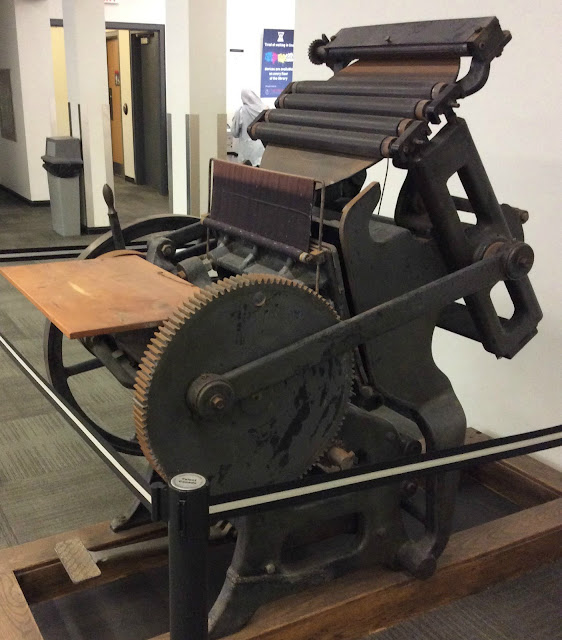Win $1000 in our Book Arts Lab imprint design contest!
The new Carleton University Book Arts Lab needs an imprint and we are looking to our community to help us come up with one. We also have $1000 to give to the winning designer.
From September 6 to October 4 we’ll be opening this contest to anyone who would like to design a visual representation of what The Book Arts Lab imprint could be.
The winning design will be awarded a cash prize, in the amount of $1000 (CDN).
Read through contest details here before submitting!
If you have any questions, please email them to mike.reynolds@carleton.ca.
What is an imprint?
The name of a press or a publisher, often accompanied by a logo. The name can reflect the purpose of the press, its character, an individual, a place, etc.
How are presses named?
Carefully. Like branding, it is unthinkable to change an imprint once established. The two largest imprints in the world today, namely Hachette and Penguin-Random House are named after, respectively, a hatchet; an ungainly, comical, flightless bird; and a mission to print random titles. Certainly, if created today, none of these imprints would have been chosen. And yet, they survived and still thrive.
To name a press, one must have an understanding of its purpose, location, associations, specializations or areas of interest, etc.
What is this Press about?
In the case of this yet-to-be-named press, it will be located in a large glass-walled Book Arts Lab on the main (2nd) floor of MacOdrum Library at Carleton University in Ottawa. (In this description alone, there are half a dozen possible names, including Yet To Be Named Press, along with MacOdrum Press, Fishbowl Press, Second Storey Press, Carleton Press and so on).
Unlike most other presses, the Book Arts Lab will be equipped with "old school" technology to be used to further academic understanding by providing experiential learning opportunities for students, faculty, staff and the public. The limited output will be posters, broadsides, books and woodcut illustrations printed on vintage presses, hand bound using traditional techniques, incorporating hand-lettered calligraphy and hand-made paper.
Why is it such a big deal?
It's like naming a boat; it requires some thought.
Has the name been used? If so, it's best not to confuse bibliographers and reference searches with unnecessary duplication. It may be historically interesting to call it the Aldine Press, after the famous press of the great renaissance printer Aldus Manutius but that could be seen as pretentious grandiosity.
Is the name appropriate? Naming it Whatever! Press might be pop-culture current, but does not reflect well the press described above. And it may not age well.
Examples
- Virago Press - feminist literature (a virago is a woman warrior)
- Bloomsbury Press - private press belonging to Virginia Wolf, named after the estate which also lent its name to the group of writers, artists (and economist) who made up the Bloomsbury Group
- McClelland & Stewart - named after founders
- The Kelmscott Press - after William Morris' home
- The Oxford University Press - book publisher attached to the university
- Golden Cockerel Press - after the animal, they produced fine, well-designed and exquisitely illustrated books through the early-mid 20th century
- Union Press - named after the Union Pub, where the three principals failed to agree on any other imprint name
About the Book Arts Lab
In its next 100 years, our Chandler and Price press will become the centerpiece of a living book arts laboratory within MacOdrum Library. Teamed with a nineteenth-century iron press and a twentieth-century flatbed press, we will demonstrate document production throughout the course of Canadian history. In addition, we will exhibit the creation of medieval manuscripts to explain how scribes sewed, ruled, wrote, and illuminated books for over a thousand years. We will also display bookbinding tools, early printed books from Carleton’s rare books collection, and even a tool that many students have never used: the typewriter.
This unique initiative has already begun to build community. Plans for the book arts laboratory have been a collaborative effort on the part of alumni, staff, and faculty, and have captured the imagination of professors from Canadian Studies, Communications and Journalism, History, Industrial Design, and especially English, which houses a unique doctoral program in the Production of Literature. Our team has been reaching out to institutions in Ottawa such as the Canada Science and Technology Museum, to the local book arts community, to individual printers and artists, and to other universities with thriving book arts laboratories across North America. Carleton students will have an opportunity for experiential learning in their classes; students and members of the community at large will look on with curiosity through the laboratory’s glass walls; printers and artists from the Ottawa area will enliven the arts on campus and beyond.

.jpg)


Comments
Post a Comment